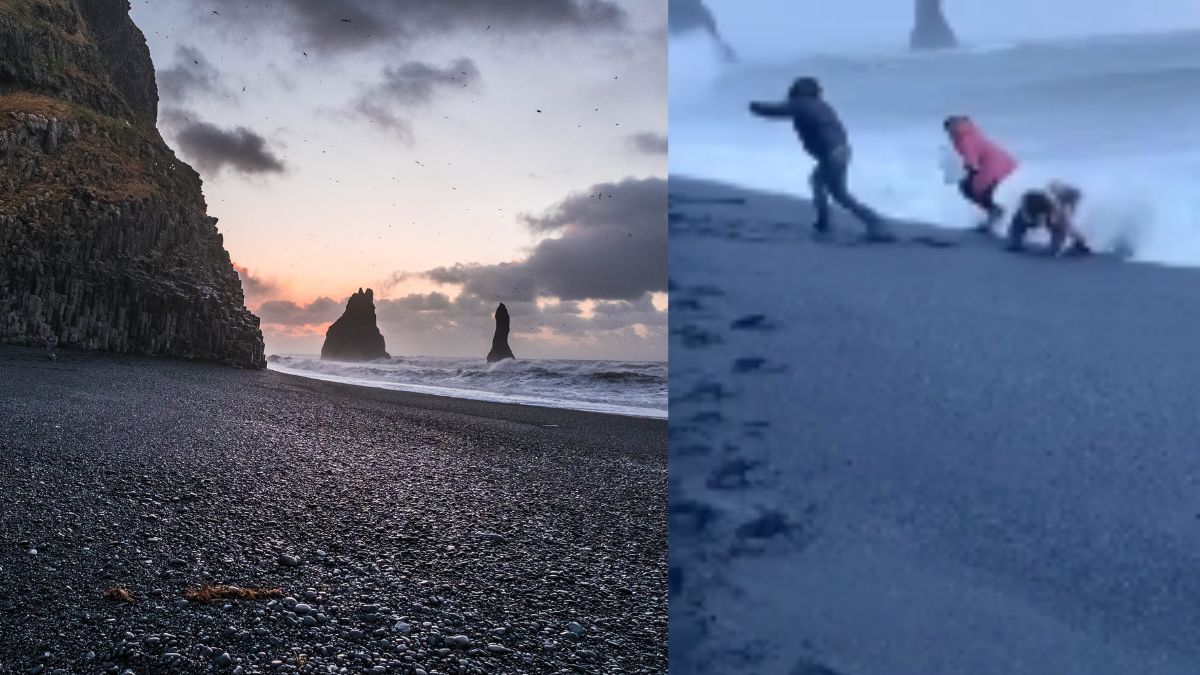You must have heard people say that one must make sure to follow rules and regulations at every new place they visit, especially while travelling to a different country, state, or even city. Many times, when you don’t do this, it might end up causing you huge unwanted trouble. Something similar happened with a group of tourists at Iceland’s most dangerous beach as sneaker waves almost washed them off the sea. Here’s what sneaker waves are:
Sneaker Waves Caused Trouble To Tourists In Iceland
A man and a woman were seen walking towards the shoreline and posing for a photo on Iceland’s Black Sand Beach, before almost getting swept out to sea by sneaker waves.#Iceland #dangerous #Blacksand #beach pic.twitter.com/Svtpdv4NSZ
— Chaudhary Parvez (@ChaudharyParvez) November 26, 2023
At Black Sand Beach, the riskiest beach in Iceland, a group of tourists was almost heard on camera being swept out to sea while attempting to take a picture. Walking towards the coastline, a man and a woman were observed raising their hands above their heads to take a picture.
A little while later, a sneaker wave smashed into the store. The tourists attempted to flee as it extended upward, but their attempts were unsuccessful because of the wave’s powerful hold. After they both fell, the man was able to hold the woman and save both of them.
Sneaker waves kill more people along the West Coast than all other weather-related disasters combined. Deadly, larger-than-average swells, known as sneaker waves, can overtake the unsuspecting with an unexpected, abrupt surge that can occur dozens of feet higher up the beach than anticipated.
When people are caught off guard, the outcomes might surprise them and turn deadly for beachgoers. A few waves have the power to break over 150 feet up the beach, toppling trees and other huge items.
Warnings For Visitors
Currently more dangerous than #icelandvolcano and #Icelandearthquake is the sneaker waves at Black Sand Beach or #Reynisfjara, a popular spot in Iceland. Extreme danger! Many tragic accidents happen there. I wish tourists in this video safety. https://t.co/X2qF8MU4Fb
— He Rulong 何儒龙 (@HeRulong) November 20, 2023
Because of their high slopes, rocky coastlines—particularly those in Northern California, Oregon, Washington, and Canada—are known to encounter these waves without notice.
It is important to warn visitors to this black sand beach in Iceland of the possible risks associated with the beach. First of all, Reynisfjara’s booming waves are especially frightening because they frequently surge farther up the beach than most people would think.
Sneaker waves are what they are called, and they can show up when you least expect it, even on very still days. Since there are no large landmasses between Antarctica and the Reynisfjara shores, waves have thousands of kilometres to travel before breaking.
It is recommended that visitors maintain a safe distance of at least 30 metres (100 feet) from the waves and never turn their backs on them.
Also Read: 4 Places To Visit To Grab The Best Malai Makhan This Winter Season
More About Reynisfjara

This beach, with its massive basalt stacks, crashing Atlantic waves, and breathtaking views, is regarded by many as the most exquisite black sand beach in Iceland. Reynisfjara was named one of the top 10 non-tropical beaches in the world by National Geographic in 1991.
Reynisfjara is a well-liked stopover for tourists travelling down the well-known South Coast. It is located around 112 miles (180 kilometers) from Reykjavik, the capital of Iceland.
When visitors arrive at the beach, they will notice rugged sea stacks off the shore. Thousands of seabirds nest on the sea stacks themselves. Birdwatchers must visit this site because it is home to species such as guillemots, fulmars, and puffins that nest on the cliffs.
What are your views?
Cover Image Courtesy: @ChaudharyParvez and Canva
For more such snackable content, interesting discoveries and latest updates on food, travel and experiences in your city, download the Curly Tales App. Download HERE.
Good news! We are on WhatsApp! Subscribe to Curly Tales WhatsApp Channel to stay up-to-date with exclusive content and BTS. Join HERE.




